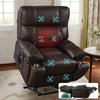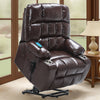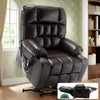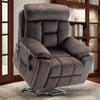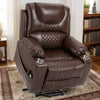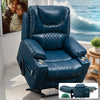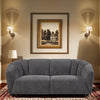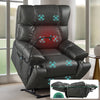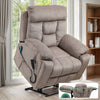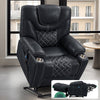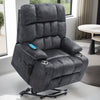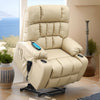Understanding the Differences: Power Lift Chairs and Traditional Recliners
The Mechanism Behind Power Lift Chairs
Power lift chairs are a modern take on the classic recliner. They use an electric motor to tilt and raise the chair. This helps seniors stand up or sit down with ease. The key feature is the lifting mechanism. It gently pushes the entire chair up and forward. This motion assists the user in getting to a standing position.

The controls are usually simple. They often come as a handheld remote with big buttons. Some models have the controls built into the armrest. Users can adjust the chair to various positions. These include sitting, reclining, and the lift position. Many power lift chairs also offer extra features. These may include heat, massage, or even USB charging ports.
Key Features of Traditional Recliners
Traditional recliners have been a living room staple for decades. They offer comfort and relaxation without electric components. The main feature is the manual reclining mechanism. It's usually operated by a lever on the side of the chair. When pulled, it allows the backrest to tilt backward. At the same time, a footrest pops out from the front.
Most traditional recliners have three main positions. These are upright, partially reclined, and fully reclined. The chair's movement relies on the user's body weight and strength. This can be a drawback for seniors with limited mobility. However, traditional recliners are often more affordable. They also don't require electricity to function.
Evaluating the Benefits: Power Lift Chairs for the Elderly
Ease of Use and Comfort
Power lift chairs offer significant benefits for seniors in terms of ease of use. The electric mechanism does all the work. This means no strain on joints or muscles when changing positions. Users can adjust the chair with the push of a button. This is ideal for those with arthritis, back pain, or limited strength.

Comfort is another major advantage. Many power lift chairs come with plush padding and ergonomic design. They often have multiple reclining positions. This allows users to find the perfect angle for reading, watching TV, or napping. Some models even have lumbar support and adjustable headrests. These features can help alleviate pain and promote better posture.
The Role of Power Lift Chairs in Mobility and Independence
Power lift chairs play a crucial role in maintaining seniors' independence. The lifting feature helps prevent falls when standing up. This is especially important for those with balance issues or weakness in their legs. By making it easier to get in and out of a seated position, these chairs encourage mobility.
Using a power lift chair can also reduce the need for assistance from caregivers. Seniors can change positions on their own, fostering a sense of self-reliance. This independence can boost mental health and overall quality of life. For those recovering from surgery or dealing with chronic conditions, a power lift chair can be a valuable tool in maintaining daily routines.
Considerations and Recommendations for Senior Living Spaces
Assessing the Space and Compatibility for Power Lift Chairs
When considering a power lift chair, it's important to assess the living space. These chairs often require more room than traditional recliners. They need space to fully recline and lift without hitting walls or furniture. Measure the area where the chair will be placed. Include space for the chair when it's fully extended.

Consider the chair's proximity to electrical outlets. Power lift chairs need to be plugged in to operate. Using extension cords is not recommended for safety reasons. Also, think about traffic flow in the room. The chair should not block walkways, especially when in the lifted position. If space is limited, look for compact models designed for smaller areas.
Expert Advice on Selecting the Right Power Lift Chair Recliner
When choosing a power lift chair, consult with healthcare professionals. They can offer advice based on specific health needs. Consider factors like the user's height and weight. The chair should provide proper support and fit comfortably. Look for models with a weight capacity that exceeds the user's weight.
Pay attention to the chair's construction and durability. High-quality materials and sturdy frames are essential for long-term use. Test the controls to ensure they're easy to understand and operate. Some seniors may prefer simple, large buttons over complex touchscreens. Consider chairs with battery backup in case of power outages.
Lastly, think about additional features that might benefit the user. Heat and massage functions can help with pain relief. USB ports can be handy for charging devices. Some chairs offer "zero gravity" positions for improved circulation. Remember, the best chair is one that meets the individual's specific needs and enhances their daily life.








